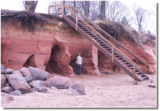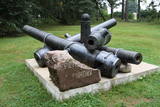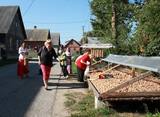| Nr | Nosaukums | Apraksts |
|---|---|---|
|
Ainavisks jūras viļņu izskalots smilšakmens atsegums
dienvidos no Zaķupes ietekas.
|
||
|
Ēka, kuru uzcēla 1933. g., ir
viena no Latvijas spilgtākajām nacionālā
romantisma celtnēm. Tā sākotnēji kalpoja kā
plašākā apkārtnē pazīstamais restorāns
“Jautrais ods”. Pēc 2. Pasaules kara ēkā tika
izveidota bērnu sanatorija “Meža māja”.
1997. g. līdz ar Ķemeru nacionālā parka
izveidi Meža māja kļuva par parka
administrācijas ēku un vienlaikus arī par
modernu parka apmeklētāju centru, un norises
vietu dažādiem vides izglītības pasākumiem.
|
||
|
Meklējamas Lizuma ciema dienviddaļā. Tās ir vienas no retajām vējdzirnavām (1880. g.), kas saglabājušās labā stāvoklī. Mūsdienās dzirnavas ir gleznotājas Ilonas Brektes īpašums. |
||
|
Sabiles Sidra nams atrodas pašā Sabiles centrā, pie vēsturiskā Sabiles vīna kalna. Tajā tiek piedāvātas sidra un vīna degustācijas. Sidra nams atvērts vasaras sezonā, bet degustācijas ziemas sezonā iespējamas Sabiles Sidra darītavā, Rīgas iela 22. Iespēja iegādāties gan Sabiles sidru, gan dažādu Latvijas vīndaru vīnus. |
||
|
Darbnīcā apskatāmi koka šķīvji u.c. izstrādājumi (izmanto daudzas vietējo koku sugas), kas veidoti neparastā tehnikā, atsedzot koka īpatnējo tekstūru. Gatavajos traukos meistarīgi integrēts dzintars, kauls un brieža ragu materiāls. Greb karotes ar etnogrāfiskām zīmēm. Meistara darbu iegāde, pasūtīšana un koka mēbeļu restaurācija. |
||
|
Doles salā (Latvijas lielākā upju sala) atrodas Doles muižas dzīvojamā ēka (celta 1898. g.) - Lēvisu of Menāru dzimtas īpašums. Doles muižas ēkā ir izveidots Doles muzejs ar bagātīgu eksponātu klāstu, kas vēsta par cilvēku dzīvi Daugavas krastos. Blakus esošajā parkā (etnogrāfiskas ēkas, nēģu un lašu tači) atrodas arī pieci unikāli lielgabali, kas uzieti Salaspilī, ceļot jauno stadionu. Šajā vietā 1910. Gadā atradās cara armijas karaspēka nometne un tika atklāts piemineklis Pēterim I. Vēl viens no šeit atrastajiem lielgabaliem atrodas paša muzeja ekspozīcijā.
|
||
|
Peipusa ezera piekrastē ir sastopami arī citi gar vienīgo ielu sarindoti ciemati – Kolkja un Varnja, kas izveidojās pirms vairākiem gadsimtiem, kad, glābdamies no Krievijas valdības vajāšanas, šeit patvērumu rada vecticībnieki. Kolkjā ir apmeklējams vecticībnieku muzejs (www.hot.ee/kolkjamuuseum) un Sūr-Kolkjas vecticībnieku lūgšanu nams. Ciemā darbojas vecticībnieku baznīca un Varnjas Dzīvās vēstures muzejs (www.starover.ee). Muzeja eksponāti uzskatāmi stāsta par Peipusa vecticībnieku dzīves stilu vairāk nekā 350 gadus ilgā laika posmā. |
||
|
"Ziedlejas" piedāvā pirts kūres un pasākumus laikmetīgā dizainā veidotajā Stikla pirtī, Sirmās egles dūmu pirtī un melnajā pirtī, kas atrodas neskartā meža nostūrī. Rituālajā pirts kūrē ietilpst sildīšana, augu kompreses, augu skrubis, lielā pēršana, peldināšana dīķī, masāža ar ārstniecisko eļļu un medu, ievibrēšana ar skaņu, tējas, pašu cepta maize. Pirts kūre ilgst četras līdz piecas stundas, un to vada pirts meistars. Iespējamas dažādas meistarklases saistībā ar pirts rituāliem un augu izmantošanu dziedniecībā un skaistumkopšanā un atbilstošu preperātu izgatavošanu. Tiek piedāvāta velo noma, kurā ietilpst pieeja Ziedleju xc/enduro takām, velo treniņi un velo gida pakalpojumi. Tāpat iespējama komandu saliedēšanās pasākumu organizēšana un vadīšana, kā arī kolektīvu komunikācijas treniņi. |
||
|
Atrodas Sakas un Liepājas ielas krustojumā. Ēka, kas šobrīd atrodas sliktā stāvoklī, celta 19. gs. vidū. |
||
|
Plāča centrā pie Inčukalna – Valkas autoceļa (A3) atrodas Teodora Zaļkalna darinātais piemineklis Ziemeļlatvijas atbrīvotājiem 1919. gadā. Uz pieminekļa iekalti Edvarta Virzas teiktie vārdi: „Kamēr vien labību šais laukos sēs, Jūs slavinās un godam pieminēs”. Uz pieminekļa attēlots zemnieks ar zobenu pie iejūgta zirga. |
||
|
Veidots 1900. gadā pie Pērses ietekas Daugavā (tagad – Pļaviņu HES ūdenskrātuvē) un tajā apskatāmi 17. gs. zviedru lielgabali un viduslaiku kapu pieminekļi. Parkā (pie vidusskolas) atrodas atjaunotā strūklaka „Fauna galva”, kas 20. gs. trīsdesmitajos gados atradās netālu no leģendārā Pērses ūdenskrituma (tagad zem ūdens), kura vietu upes krastā iezīmē akmens skulptūra „Pērses meitene” (autors: J. Zihmanis). Celiņš aizved gar tēlnieka Ģ. Burvja veidoto 11 m augsto koka skulptūru „Mūžībai” un koktēlnieku – brāļu Rūrānu veidoto „Pūcīti”. |
||
|
Ap 400 gadus vecajos (iespējams, - vecākie Latvijā) muižas pagrabos piedāvā Kurzemes vīndaru mājas vīna šķirņu degustāciju (3 – 7 vīni), kā arī Šlokenbekas muižas īpašo vīnu ar vietējiem lauku labumiem (sola pārsteigumu!). |
||
|
Tradicionālo amatu centrs, turpinot keramikas amata tradīcijas, ik gadu organizē radošās bērnu nometnes, rīko keramikas darbu izstādes, organizē izglītojošas programmas par tradicionālajiem svētkiem. |
||
|
Atrodas Mazā Subates ezera ziemeļaustrumu krastā.Dievnams celts 1685. – 1686. g. bizantiskā stilā pēc Prodes muižas īpašnieka H. F. Ostena - Zakena rīkojuma. Šī ir vienīgā Latvijas baznīca, kuras arhitektūra atgādina 17. gs. beigām raksturīgās ideālā protestantu dievnamu formas. Interesanti ir ēkas stūros izvietotie mazie tornīši. Dievnama iekšpusē atrodas bagātīgi ornamentēts un skulptūrām rotāts kokgriezumu ansamblis, t.sk. - 17. gs altāris, kancele un biktssols, kā arī 17. - 18. gs. mākslas darbi un 1682. g. atliets zvans. Jāpiemin, ka daļu no baznīcas interjera ir veidojuši Stelmužes koktēlnieku skolas amatnieki.
|
||
|
Atrodas mežā, netālu no Kaltenes. Labiekārtota (laipas, kāpnes, informācijas stendi) taka, kas iepazīstina ar Latvijai samērā neparastu dabas pieminekli (aizsargājams) – Kaltenes kalvām, kas ir lieli, līdztekus Rīgas jūras līča krasta līnijai orientēti laukakmeņu krāvumi. Uzskata, ka tos veidojuši Baltijas ledus ezera ūdeņi un ledi. Garums – ap 1,5 km. |
||
|
The tour introduces modern day life in rural Finland, Estonia and Latvia and includes visits to small farms raising livestock and producing delicious foods, and to ethnographic villages preserving the traditional lifestyle in a contemporary environment. The tour also involves sites of historical and cultural interest. |
||
|
In terms of shape, this is one of the most diverse areas of uncovered sandstone in Latvia. Found on the right bank of the Gauja river, the Sietiņiezis is up to 15m high. Small holes that can be seen in the cliff face are created by single and protected insects, which carve tiny caves in the cliff for their caterpillars. A circular and well appointed trail, with stairs, has been installed. It is 1.5 km in length and will take an hour or so to traverse. Objects are in the Gauja National Park.
|
||
|
The owner of the farm grows petunias, geraniums, balsams, asters, snapdragons and other plants, also designing beautiful pots of flowers. She organises seminars on biological farming. Visitors can purchase plants, pick black currants from a bush, and pick tomatoes from a vegetable bed. Tastings are available, and there are rabbits on display, as well. |
||
|
Located in the Mežotne Castle, the saloon offers fine and tasty dishes and beverages. Tours of the ornate castle are available, and the location has one of the loveliest English-style landscape parks in Latvia. Latvian cuisine: Potato pancakes, rolled marinated herring, trout with potatoes in their jackets, blood sausage with lingonberry sauce, grey peas with bacon, stacked rye bread with cranberry jam and whipped cream. Special foods: “Bauska Thaler” – pork in the form of a thaler with a sauce made with Bauska beer. |
||
|
It is possible to look at African ostriches of different ages; to listen to stories about or of ostriches. It is possible to buy crafts made of ostrich feathers, skin and grease, fresh ostrich eggs. |
||

























